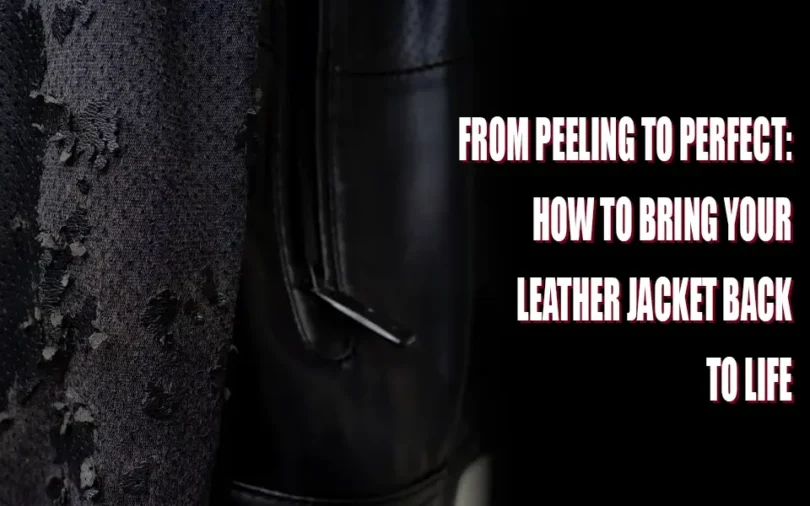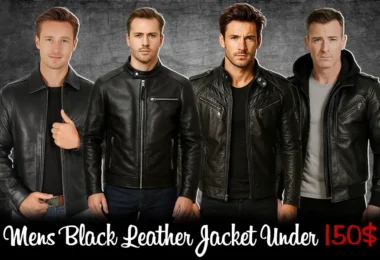Is the leather on your beloved jacket peeling? Oh No! That hurts. That’s where we’ve all been. You get this classic, ultra-soft item, wear it constantly as if it were your second skin, and then all of a sudden, it begins to flake. There is genuine sadness. You look at it, trying to decide if it needs fixing or whether you should just give up and let it be.
Don’t worry, this guide will help you and your jacket. This complete fix and purchasing guide will teach you why leather peels, how to mend it, and what to look for in a jacket that won’t betray you again, whether you’re attempting to save the one you currently own or make a wise investment in your next one.
Why Leather Jackets Peel: The True Villain
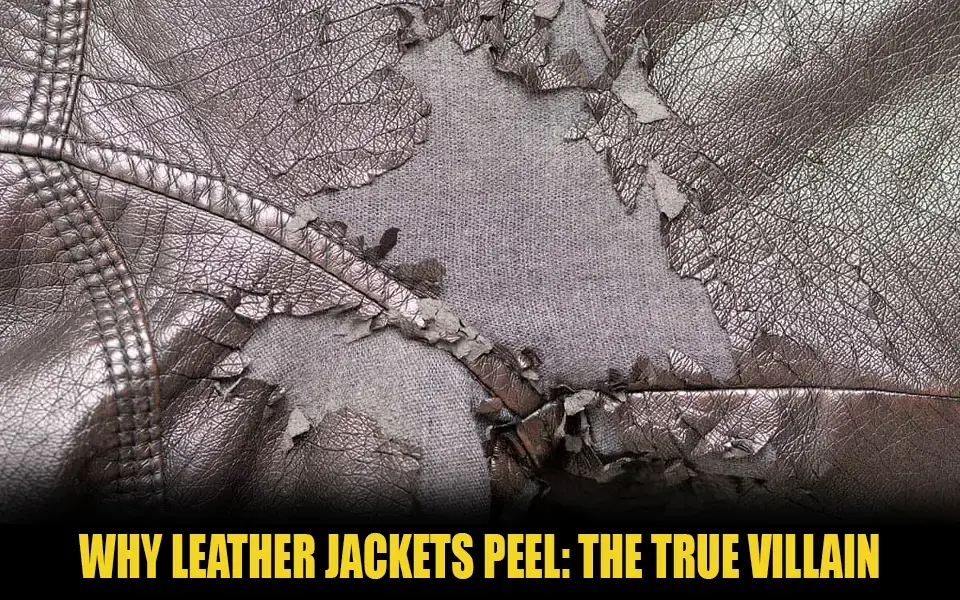
Let’s find out who really caused that sad peel before you blame yourself (or your closet):
- The Risks of Sunlight
Like skin, leather dries out after being in the sun for too long. The sun’s removal of its natural oils and moisture leaves the surface weak, brittle, and more susceptible to peeling or cracking.
- Moisture Madness
Despite their seemingly innocuous nature, water and humidity pose a significant threat. Rain, perspiration, and humidity wear down the surface finish, causing layers to separate and peel.
- Dangerous Chemicals and Cleaners
It is absolutely forbidden to use ordinary soap, alcohol wipes, or any kind of detergent on leather. After using these products, the material will lose its natural oils and become weak, drab, and flaky.
- Wear and tear
Is that wear and tear caused by dragging bags, tucking sleeves, or rubbing against rough surfaces? The outside polish of the jacket eventually fades away, especially around the cuffs and elbows, which experience a lot of wear and tear from daily use.
- Insufficient Storage
Storing the jacket in a stuffy closet, a wet cellar, or plastic may cause it to suffocate. Air circulation is essential for the softness and strength of leather.
- Totally disregarding
If you don’t moisturize your skin regularly, it will break. The same goes for upkeep. Leather becomes rigid and begins to flake when not conditioned regularly.
Expert Advice: It’s probably not genuine leather if your “leather” jacket begins coming off at a rapid pace. Leather with a polyurethane covering or bonded leather, which is a combination of shredded fragments, is likely the material used. As time goes on, genuine top-grain or full-grain leather will age elegantly and hardly peel.
If you want to avoid peeling or cracking, choose a jacket made from high-quality leather. Genuine full-grain or top-grain leather, unlike bonded leather, is less prone to damage over time. Explore our Men’s Black Leather Jacket Under $150 collection for quality jackets that can stand the test of time.
Leather Peeling Got You Down? Here’s the Fix You Need.
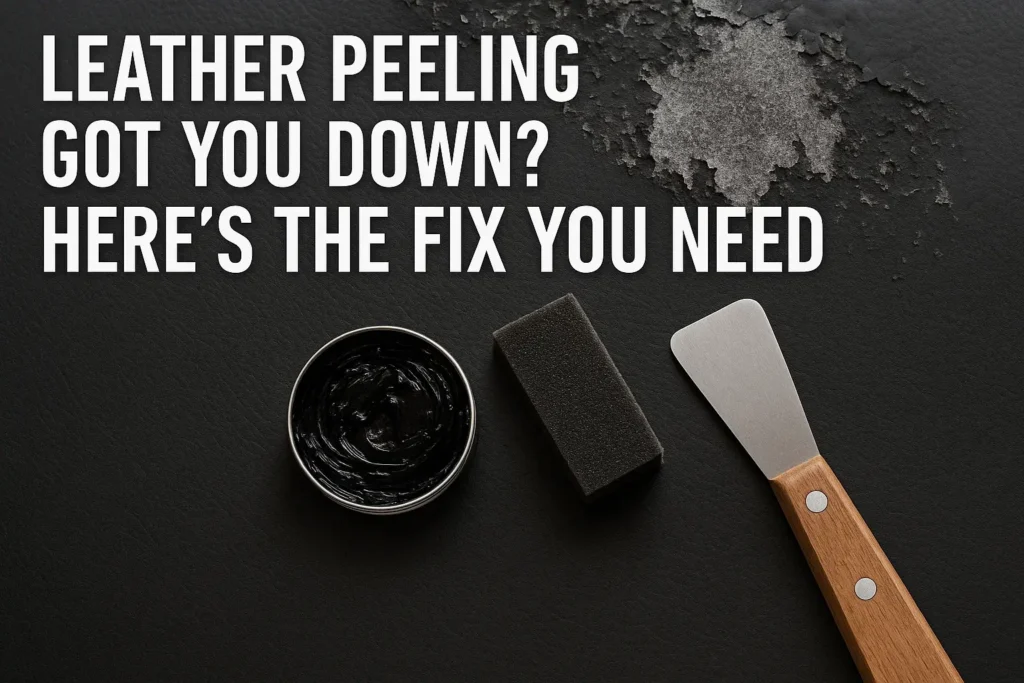
Allow us to commence our task now that we have apprehended the offenders. It is possible to fix a peeling jacket if the damage is not extensive. Imagine it’s a repair as a sort of leather salon treatment.
First Step: Evaluate the Damage
Take a positive, intent look around as you lay your jacket flat. Please determine whether this is a minor shedding issue or a more significant problem.
- You may simply take care of the little peeling on your own.
- When cracking becomes severe, it’s best to seek the advice of an expert in leather restoration.
- You will be able to choose the appropriate remedy once you understand the situation.
Second Step: Get the Surface Clean
Preparation is key before applying any adhesive or filler.
To clean surfaces, use a gentle microfiber towel or brush. Thereafter, use a leather cleaner designed for your jacket type to gently wipe off the affected area. Avoid ever using water or strong soaps.
Ensure that the jacket is allowed to air dry entirely at room temperature. Skip the sun, the hairdryer, and any expedient routes.
Third Step: Select the Method of Repair
Choose your repair method according to the severity of the damage:
- Regarding Mini Peels:
Use an adhesive or glue that is suitable for leather. Before smoothing out the peeling edge, apply an appropriate quantity and push lightly. Before it dries, wipe off any excess.
- To Fix Chips or Rust:
Get a repair compound or leather filler. Once it has dried, gently sand the surface to remove any imperfections. Apply it evenly using a tiny spatula or cotton swab.
- For Areas with Severe Damage:
A leather patch would be useful! Simply use a little amount of leather glue, cut a patch that matches the color and texture of your jacket, and press it into place. After that, let it sit overnight so it can set right.
This process shouldn’t pose any issues. Just bring it to a leather repair specialist if the damage seems too severe or if you don’t feel confident restoring it yourself. Your jacket may be restored to a like-new condition by having it recolored and resealed.
Avoid Peeling in the Future by Handling It Like Gold
We can ensure that your jacket remains in pristine condition after its restoration or, alternatively, that your new one remains faultless. Love for leather means life.
1. Keep out humidity and heat.
Never wear it in really hot weather or when it’s raining heavily. In the event that it becomes wet, pat it dry gently and hang it in an area with good ventilation.
2. Give It a Regular Shine
Use a high-quality leather conditioner every three to six months. It maintains the suppleness and hydration of the hide. To be sure the color won’t fade, try a little area first.
3. Advanced Storage
To keep its form, hang it on a wide, cushioned hanger. Keep in a climate that is cool, dry, and well-ventilated. To keep moisture out, don’t use plastic coverings.
4. Predictable Cleaning Schedule
Wipe it down with a gentle cloth after each use. You may think of it as “skincare” for your jacket. A little TLC now can save you a lot of trouble in the long run.
Need more detailed care tips? Read our Leather Jacket Care & Cleaning Guide for safe cleaning methods and product recommendations.
How to Pick a Water-Repellent Leather Jacket: A Buyer’s Guide for the Savvy Consumer
The true improvement is figuring out how to choose a high-quality leather jacket that will last for decades. We will dissect the features that distinguish a clone from an authentic one.
1. Examine the Subject Matter
The kind of leather matters much when purchasing. “Oh no, it’s peeling already” is quite different from good, awful, and ugly.
Satisfaction Guaranteed With Our Full-Grain Leather: The skin is the most superficial covering of the animal, and it has several desirable qualities: it is tough, long-lasting, and textured naturally. It changes rather than peeling.
Leather with a Top Grain: It is very robust and resistant to breaking; it has been gently sanded to make it seem smoother.
Real Leather: It’s not as high-quality as it sounds. Because it is constructed from leftover layers, it wears and peels more quickly.
Stay Well Away From Bonded Leather: Which is essentially leather dust that has been glued together. At first glance, it seems sleek and sophisticated, but its luster quickly fades.
Pro Tip: Genuine leather has a somewhat uneven texture, is warm to the touch, and is supple. The texture of faux leather is sometimes overly smooth, chilly, or even plastic-like.
2. Check the top layer.
Make sure it’s consistent. Genuine leather’s natural tone and pattern variance are two of its best features. It is probably not real if the surface is too glossy, plasticky, or flawless.
3. Verify the Quality of workmanship.
The way a jacket is put together reveals a lot about its quality. Keep an eye out for:
- Seamless construction
- A strong indicator of a sturdy zipper is the YKK brand.
- Shoulder and cuff seams that have been reinforced
- Smoothly complete the perimeter.
The difference between a “stylish” and a “built to last” jacket lies in these minute elements.
4. Keep in Mind the Silver line.
Everything on the inside is important. Opt for jackets lined with cotton or viscose—they provide breathability, comfort, and protection against perspiration damage. Your jacket’s lifetime can be reduced if it has a synthetic lining that traps moisture.
5. Select Waterproof Options
Leather with a wax coating or water-repellent finish is a good choice if you reside in a humid or wet climate. It will retain its luxurious feel while repelling water.
6. Adopt a Classic Style, Not a Fad
Quick fashion is done. Coats made of leather don’t. Keep to time-honored styles like biker, bomber, and café racer. You will never wake up and say, “This looks outdated,” since these styles are timeless.
Once you’ve found the right jacket, it’s time to style it your way. Check out some of the latest Womens leather jacket outfit ideas to see how to pair it for any occasion.
Choose Reputable Brands to Buy from
A brand that is open about materials and sources is always worthwhile. Verify the claim of genuine leather in the goods and peruse reviews prior to purchasing. It’s a red flag if they don’t say what kind of leather it is.
The Enduring Influence: Why Leather Jackets Will Always Be in Vogue
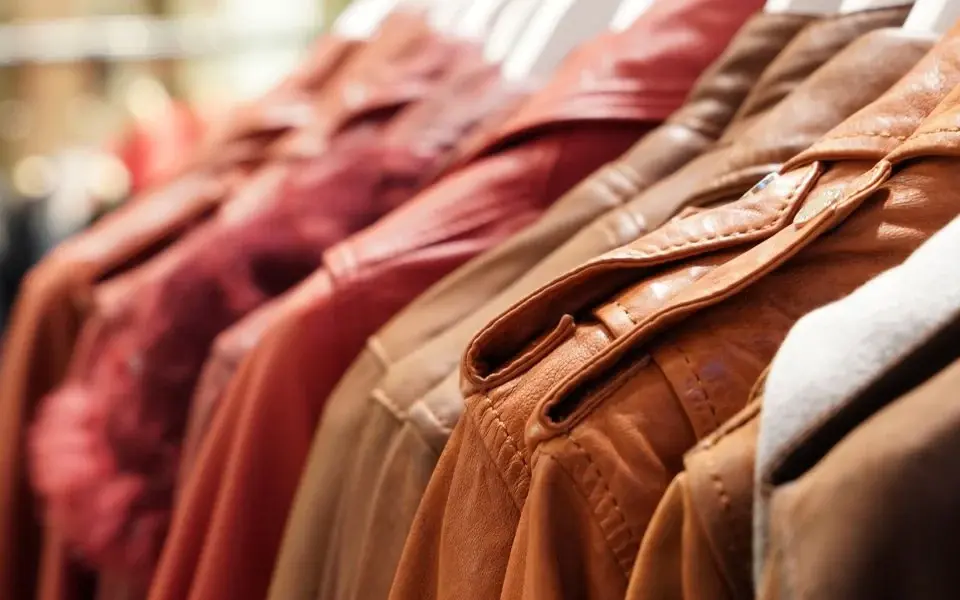
Unbelievable as it may seem, experts predict that the worldwide market for leather jackets will surpass $50 billion by the year 2030. The reason for this is that leather is more than simply a material; it really embodies a culture.
Leather jackets have been a defining fashion statement for every age, from the renegade stars of yesteryear (James Dean, Marlon Brando) to the fashion idols of today (David Beckham, Hailey Bieber). They are more than an exterior covering; they represent confidence, strength, and classic good taste.
Real leather is making a comeback, and this is happening even among the fashion-conscious Gen Z. The trick is to wear it smartly, however. Instead of buying quick fashion that rips apart, people now purchase fewer, higher-quality items.
Therefore, it’s more than simply shopping when you get a high-quality leather jacket. You are making a lasting investment.
Because Good Leather Deserves a Second Chance
A little peeling is no reason to throw out your leather jacket; it deserves better. No matter whether you’re fixing the one you already have or buying a new, high-quality one, the key is to take excellent care of it.
Maintain a steady connection with your jacket:
- Handle it with care.
- Ensure it stays moist.
- Do not let it dangle in hazardous areas.
Frequently Asked Questions:
Q1: How can I repair a leather jacket that is peeling?
A: In a word, yes. When it comes to minor flaking, glue or filler will do the trick. It is safer to see a leather repair expert for significant damage.
Q2: Can genuine leather be peeled?
A: Though it won’t peel, real top or full-grain leather may break if not cared for properly. That is prevented by proper conditioning.
Q3: What kind of leather is ideal for use in jackets?
A: When it comes to durability and the way it looks with age, full-grain and top-grain leather are unrivaled.
Q4: To protect leather, is it OK to use coconut oil or Vaseline?
A: Not perfect. These products may cause stickiness or a darkening of the color. Continue using the correct leather conditioner.
Q5: What is the average lifespan of a high-quality leather jacket?
A: If handled properly, a high-quality leather jacket can last twenty to forty years, and sometimes even longer. Great leather jackets are more than simply outerwear; they are heritage quality.

